Strategic Human Resource Management: Training & Relocation Report
VerifiedAdded on 2024/05/17
|10
|3032
|201
Report
AI Summary
This report provides a comprehensive analysis of strategic human resource management, focusing on the drivers, enablers, and barriers involved in developing and implementing HR strategies. It highlights the importance of cross-cultural training for employees relocating to China, particularly for Keith Retailers Ltd., to address cultural differences, communication challenges, and potential performance issues. The report discusses various training methods such as on-the-job training, job rotation, coaching, outdoor training, and seminars, emphasizing their role in enhancing employee skills and adaptability. It also examines the key selection criteria for employees being sent abroad, including competitive spirit, flexibility, communication skills, reliability, organizational capabilities, and teamwork. Furthermore, the report addresses the challenges employees face when relocating, such as adjustments, cost of living, and semantic barriers, and outlines the initiatives taken by the HR department to mitigate these issues, including financial assistance and accommodation support. The ultimate goal is to equip employees with the necessary skills and support to succeed in international assignments and contribute to the company's success in the Chinese market. Desklib provides access to similar solved assignments.
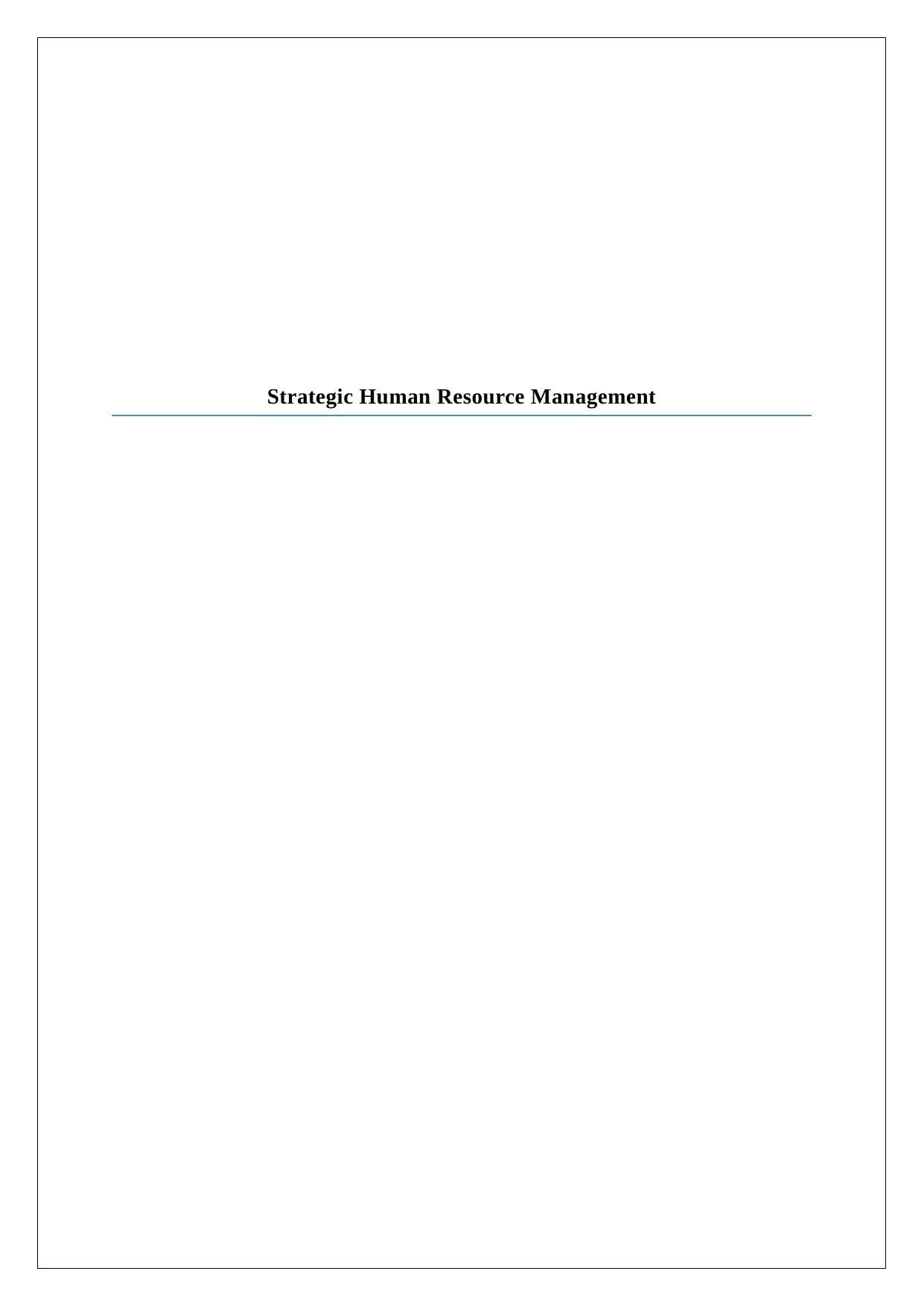
Strategic Human Resource Management
Paraphrase This Document
Need a fresh take? Get an instant paraphrase of this document with our AI Paraphraser
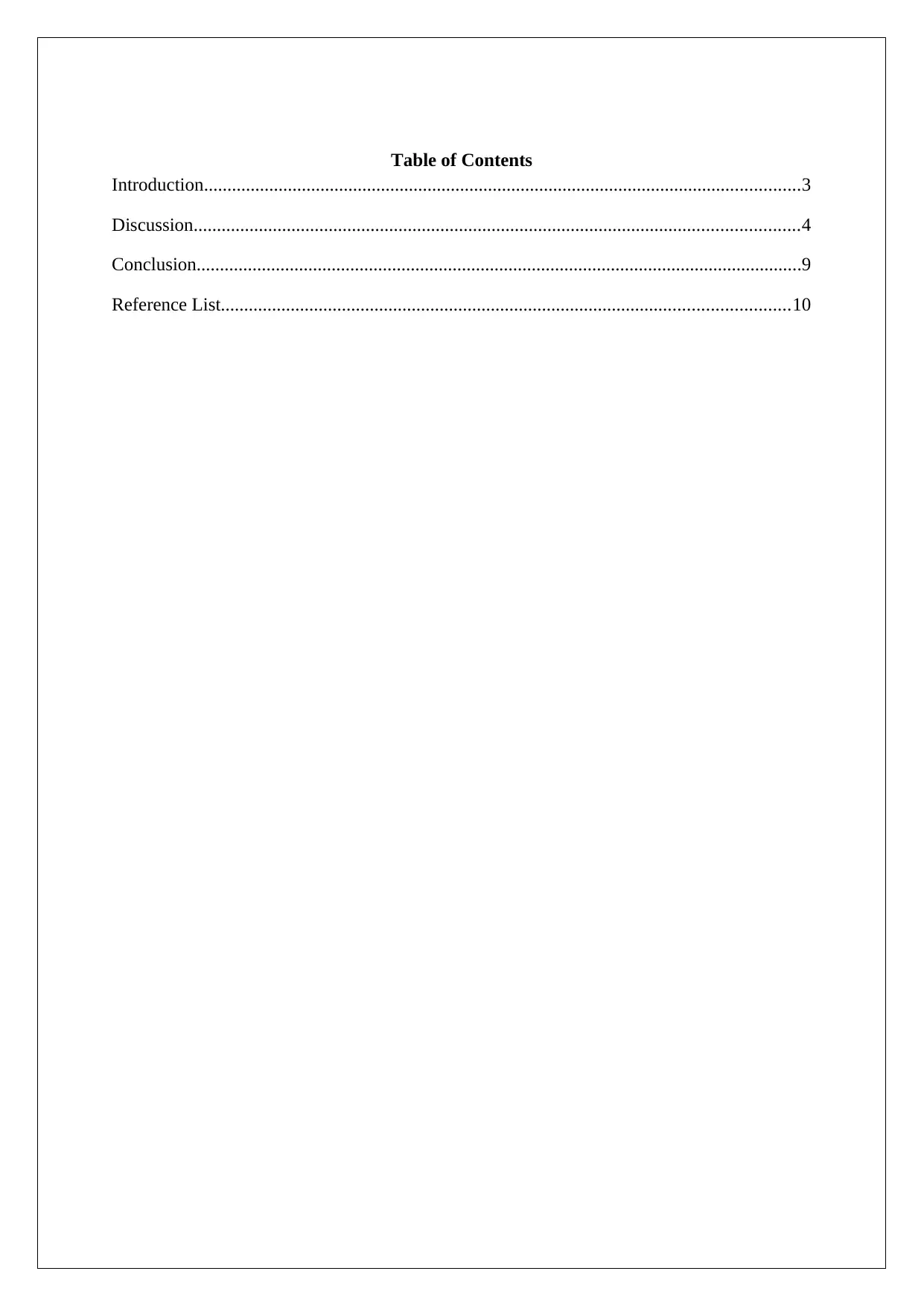
Table of Contents
Introduction................................................................................................................................3
Discussion..................................................................................................................................4
Conclusion..................................................................................................................................9
Reference List..........................................................................................................................10
Introduction................................................................................................................................3
Discussion..................................................................................................................................4
Conclusion..................................................................................................................................9
Reference List..........................................................................................................................10
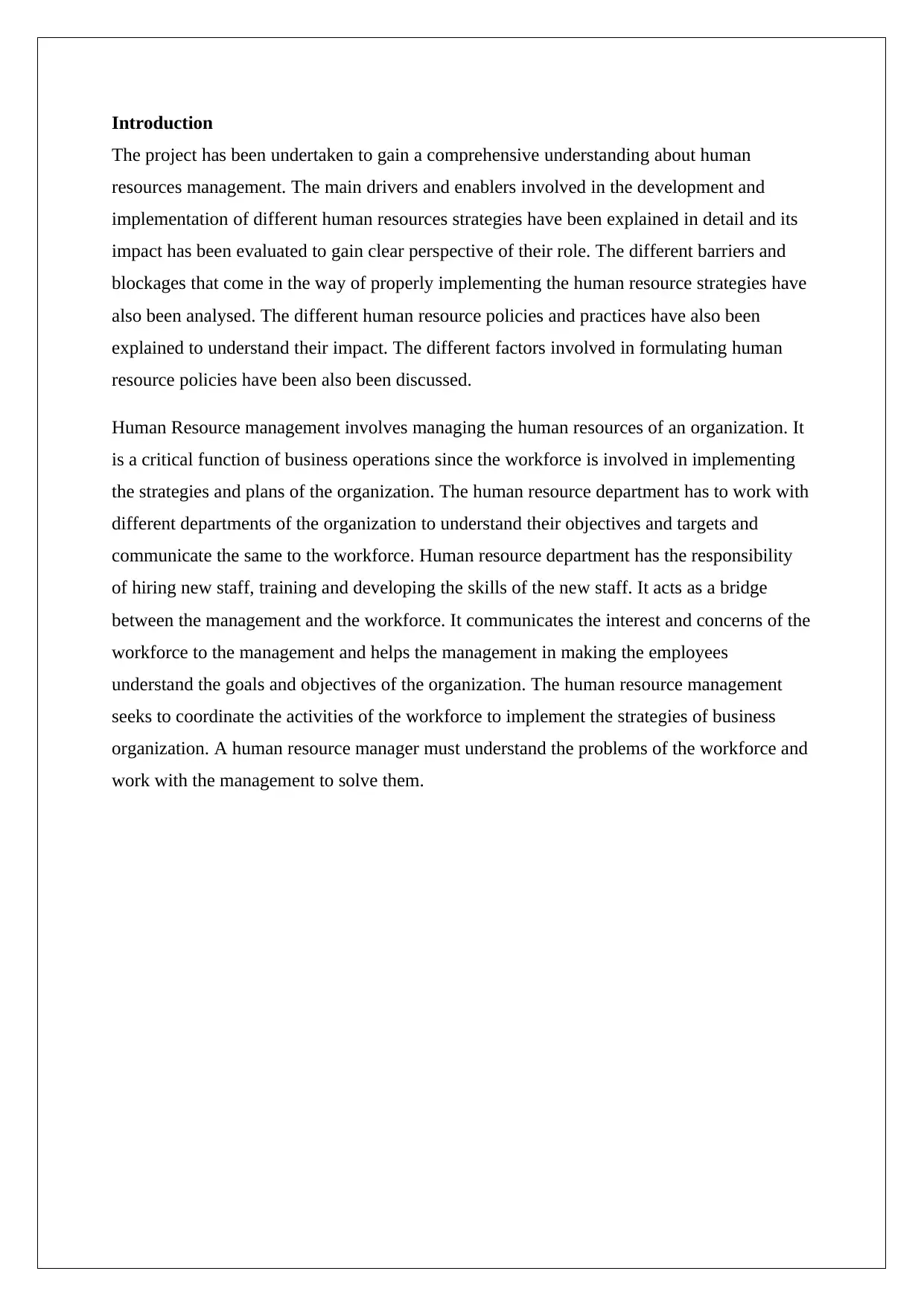
Introduction
The project has been undertaken to gain a comprehensive understanding about human
resources management. The main drivers and enablers involved in the development and
implementation of different human resources strategies have been explained in detail and its
impact has been evaluated to gain clear perspective of their role. The different barriers and
blockages that come in the way of properly implementing the human resource strategies have
also been analysed. The different human resource policies and practices have also been
explained to understand their impact. The different factors involved in formulating human
resource policies have been also been discussed.
Human Resource management involves managing the human resources of an organization. It
is a critical function of business operations since the workforce is involved in implementing
the strategies and plans of the organization. The human resource department has to work with
different departments of the organization to understand their objectives and targets and
communicate the same to the workforce. Human resource department has the responsibility
of hiring new staff, training and developing the skills of the new staff. It acts as a bridge
between the management and the workforce. It communicates the interest and concerns of the
workforce to the management and helps the management in making the employees
understand the goals and objectives of the organization. The human resource management
seeks to coordinate the activities of the workforce to implement the strategies of business
organization. A human resource manager must understand the problems of the workforce and
work with the management to solve them.
The project has been undertaken to gain a comprehensive understanding about human
resources management. The main drivers and enablers involved in the development and
implementation of different human resources strategies have been explained in detail and its
impact has been evaluated to gain clear perspective of their role. The different barriers and
blockages that come in the way of properly implementing the human resource strategies have
also been analysed. The different human resource policies and practices have also been
explained to understand their impact. The different factors involved in formulating human
resource policies have been also been discussed.
Human Resource management involves managing the human resources of an organization. It
is a critical function of business operations since the workforce is involved in implementing
the strategies and plans of the organization. The human resource department has to work with
different departments of the organization to understand their objectives and targets and
communicate the same to the workforce. Human resource department has the responsibility
of hiring new staff, training and developing the skills of the new staff. It acts as a bridge
between the management and the workforce. It communicates the interest and concerns of the
workforce to the management and helps the management in making the employees
understand the goals and objectives of the organization. The human resource management
seeks to coordinate the activities of the workforce to implement the strategies of business
organization. A human resource manager must understand the problems of the workforce and
work with the management to solve them.
⊘ This is a preview!⊘
Do you want full access?
Subscribe today to unlock all pages.

Trusted by 1+ million students worldwide

Discussion
Cross cultural dissimilarities can hamper the interpersonal relationships and communication. In
the world of business, cross cultural disfuntionalities occur on a daily basis. People from diverse
cultures interact as they are expected to deliver work and perform as a team. The aim of cross
cultural training is to develop an array of awareness in the people between whom a framework of
common cultural does not exist. Therefore, to promote clear lines of communication and better
professional relationships, Keith Retailer Ltd has prepared a training session for its employees on
cross cultural training (Lenartowicz et al., 2014).
As the team of employees are being sent to China they will be witnessing a radical difference in
the culture and lifestyle of China. The marketing strategies are different from that of UK; there is
a huge difference in the workspace environment of China and the laws relating to trade and
business is also drastically different from each other. These factors will leave the employees
startled and none of them will be able to deliver a good performance. This is where the cross
cultural training will help.
It will benefit the employees to gain knowledge about the culture and work ethics of China. It
will promote a string of connectivity between the two diverse cultures and empower them with a
sense of confidence and control over their work. The barriers of preconceived notions,
stereotypes and prejudices that obstruct the understanding of a different culture will come to an
end. Through cross cultural training the employees of Keith Retailers Ltd will understand the
market preferences and consumer behaviour structure of China. It will also help the employees
understand the sensitive issues of the nation and can prevent themselves from divulging into such
risks.
The training session of cross cultural training provided to employees will consist of an
introduction to the cultural information will be given on each meeting, and discussion sessions
will be held on topics trending in China. The group of employees will be involved in learning
activities, such as a relevant regular class, seminars and webinars and forum discussions. The
employees under training will be provided with projects such as intercultural competence
research, etc (Waddle, 2018).
On the job training is one of the earliest methods of training employees in accordance to their
functional job profile. This particular training follows the age old policy of observational
learning. On the job training is one-on-one guidance provided by the employer by assigning an
experienced employee or trainer. The training is located at the job site, where a person who
already knows how to conduct the task guides another on how to perform the task. This method is
Cross cultural dissimilarities can hamper the interpersonal relationships and communication. In
the world of business, cross cultural disfuntionalities occur on a daily basis. People from diverse
cultures interact as they are expected to deliver work and perform as a team. The aim of cross
cultural training is to develop an array of awareness in the people between whom a framework of
common cultural does not exist. Therefore, to promote clear lines of communication and better
professional relationships, Keith Retailer Ltd has prepared a training session for its employees on
cross cultural training (Lenartowicz et al., 2014).
As the team of employees are being sent to China they will be witnessing a radical difference in
the culture and lifestyle of China. The marketing strategies are different from that of UK; there is
a huge difference in the workspace environment of China and the laws relating to trade and
business is also drastically different from each other. These factors will leave the employees
startled and none of them will be able to deliver a good performance. This is where the cross
cultural training will help.
It will benefit the employees to gain knowledge about the culture and work ethics of China. It
will promote a string of connectivity between the two diverse cultures and empower them with a
sense of confidence and control over their work. The barriers of preconceived notions,
stereotypes and prejudices that obstruct the understanding of a different culture will come to an
end. Through cross cultural training the employees of Keith Retailers Ltd will understand the
market preferences and consumer behaviour structure of China. It will also help the employees
understand the sensitive issues of the nation and can prevent themselves from divulging into such
risks.
The training session of cross cultural training provided to employees will consist of an
introduction to the cultural information will be given on each meeting, and discussion sessions
will be held on topics trending in China. The group of employees will be involved in learning
activities, such as a relevant regular class, seminars and webinars and forum discussions. The
employees under training will be provided with projects such as intercultural competence
research, etc (Waddle, 2018).
On the job training is one of the earliest methods of training employees in accordance to their
functional job profile. This particular training follows the age old policy of observational
learning. On the job training is one-on-one guidance provided by the employer by assigning an
experienced employee or trainer. The training is located at the job site, where a person who
already knows how to conduct the task guides another on how to perform the task. This method is
Paraphrase This Document
Need a fresh take? Get an instant paraphrase of this document with our AI Paraphraser

frequently used as it takes only one person who has existing knowledge and experience on the
performance of the task and the instruments that are need by the person to perform the task. This
training method is considered to be highly realistic and effective as no transfer of learning is
required. On job training accomplishes the learning of a large number of employees. When an
employee learns his work on the job site and not another simulated surrounding it is called on job
training (Carr et al., 2015).
The company Keith Retailers Ltd will conduct a programme of on job training for its employees
who are being sent to China, in the job location which is situated at Beijing, China. Job rotation is
part of the training it will involve the movement of employees and their training from one certain
activity to another. Coaching will be provided by an assigned trainer and the employees will
apprenticeship in their allotted office.
Outdoor training and Seminars will be provided to the employees who are being transferred to
China by Keith Retailer Ltd. Seminars are very important for the purpose of understanding the
objectives of the company. It is crucial for the development of the company. A company will
only develop when it has efficient group of employees working for its betterment. Seminars will
help employees set goals in their mind. It will give them clarity of different business concepts.
Employees will become more efficient if they attend all the seminars and learn for themselves
how to present a business seminar in front of audience. It will help the employees of the company
more productive.
Outdoor training is an educational method that involves physical outdoor activities which are
chiefly based on pedagogy. Outdoor training is important for the employees of Keith Retailer Ltd
as it will help raise the physical, mental, social, spiritual and cognitive bar of the employees. It
focuses on building a team and helps all the employees work as a team player. The group of
employees being sent to China will not be working individually but as a complete team that
promotes the company. This method of training builds motivation and enthusiasm in the minds
of the employees. As it is clear that a group of employees will be shifted to China by the
company, the workers must be equipped with the change of situation. Outdoor training is held off
the business sites and give the employees a chance to polish their skill in dealing with sudden
change of venue and surroundings. Seminars and outdoor training programme teach the valuable
lesson of time management to the employees. Time and fiscal revenue are two most important
factors involved in a business organisation. Management of both the resources skilfully will be
considered as a precious ability of the employees. The company will train its employees
according to the methods mentioned above to inculcate a sense of exposure and responsibility in
performance of the task and the instruments that are need by the person to perform the task. This
training method is considered to be highly realistic and effective as no transfer of learning is
required. On job training accomplishes the learning of a large number of employees. When an
employee learns his work on the job site and not another simulated surrounding it is called on job
training (Carr et al., 2015).
The company Keith Retailers Ltd will conduct a programme of on job training for its employees
who are being sent to China, in the job location which is situated at Beijing, China. Job rotation is
part of the training it will involve the movement of employees and their training from one certain
activity to another. Coaching will be provided by an assigned trainer and the employees will
apprenticeship in their allotted office.
Outdoor training and Seminars will be provided to the employees who are being transferred to
China by Keith Retailer Ltd. Seminars are very important for the purpose of understanding the
objectives of the company. It is crucial for the development of the company. A company will
only develop when it has efficient group of employees working for its betterment. Seminars will
help employees set goals in their mind. It will give them clarity of different business concepts.
Employees will become more efficient if they attend all the seminars and learn for themselves
how to present a business seminar in front of audience. It will help the employees of the company
more productive.
Outdoor training is an educational method that involves physical outdoor activities which are
chiefly based on pedagogy. Outdoor training is important for the employees of Keith Retailer Ltd
as it will help raise the physical, mental, social, spiritual and cognitive bar of the employees. It
focuses on building a team and helps all the employees work as a team player. The group of
employees being sent to China will not be working individually but as a complete team that
promotes the company. This method of training builds motivation and enthusiasm in the minds
of the employees. As it is clear that a group of employees will be shifted to China by the
company, the workers must be equipped with the change of situation. Outdoor training is held off
the business sites and give the employees a chance to polish their skill in dealing with sudden
change of venue and surroundings. Seminars and outdoor training programme teach the valuable
lesson of time management to the employees. Time and fiscal revenue are two most important
factors involved in a business organisation. Management of both the resources skilfully will be
considered as a precious ability of the employees. The company will train its employees
according to the methods mentioned above to inculcate a sense of exposure and responsibility in
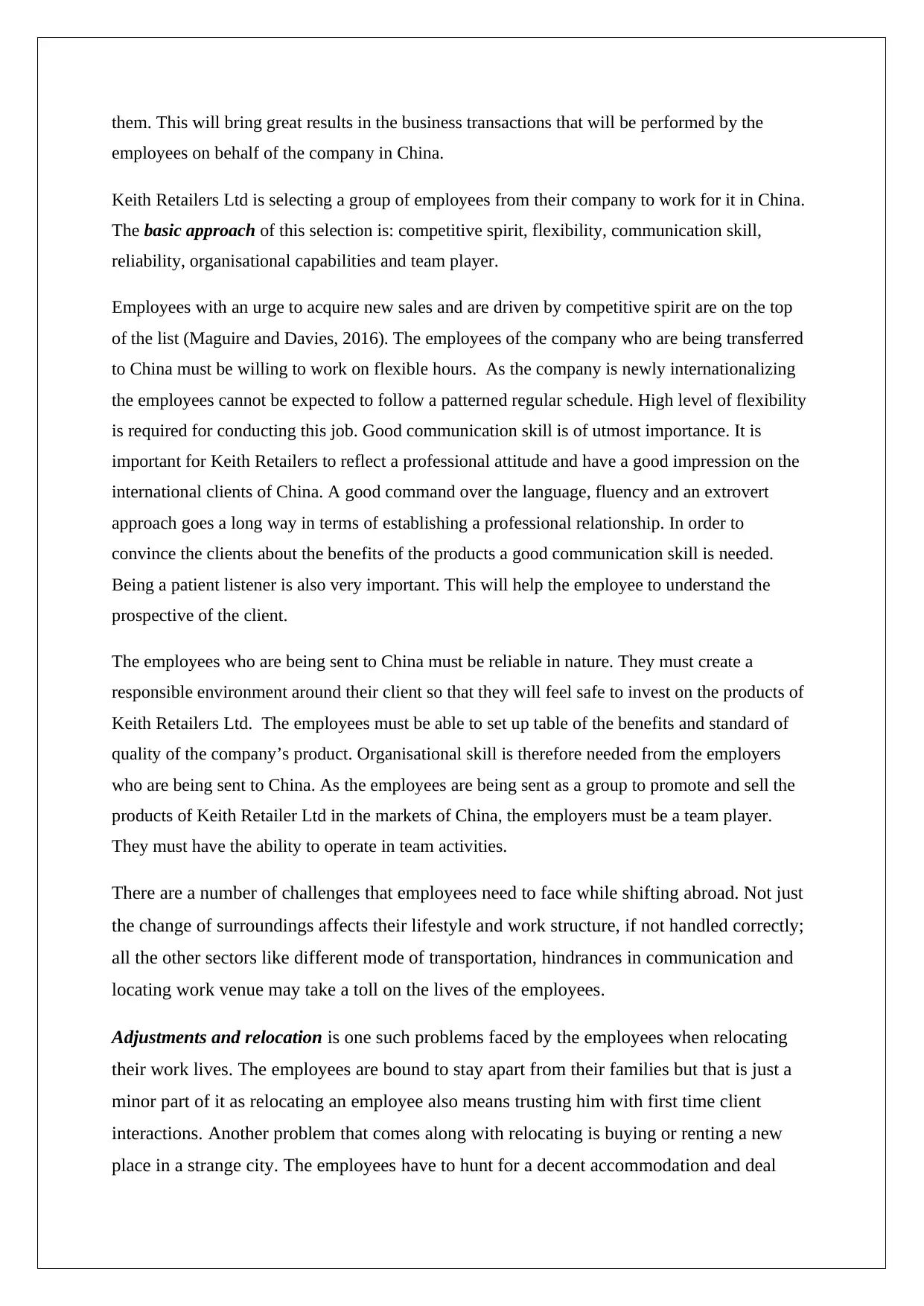
them. This will bring great results in the business transactions that will be performed by the
employees on behalf of the company in China.
Keith Retailers Ltd is selecting a group of employees from their company to work for it in China.
The basic approach of this selection is: competitive spirit, flexibility, communication skill,
reliability, organisational capabilities and team player.
Employees with an urge to acquire new sales and are driven by competitive spirit are on the top
of the list (Maguire and Davies, 2016). The employees of the company who are being transferred
to China must be willing to work on flexible hours. As the company is newly internationalizing
the employees cannot be expected to follow a patterned regular schedule. High level of flexibility
is required for conducting this job. Good communication skill is of utmost importance. It is
important for Keith Retailers to reflect a professional attitude and have a good impression on the
international clients of China. A good command over the language, fluency and an extrovert
approach goes a long way in terms of establishing a professional relationship. In order to
convince the clients about the benefits of the products a good communication skill is needed.
Being a patient listener is also very important. This will help the employee to understand the
prospective of the client.
The employees who are being sent to China must be reliable in nature. They must create a
responsible environment around their client so that they will feel safe to invest on the products of
Keith Retailers Ltd. The employees must be able to set up table of the benefits and standard of
quality of the company’s product. Organisational skill is therefore needed from the employers
who are being sent to China. As the employees are being sent as a group to promote and sell the
products of Keith Retailer Ltd in the markets of China, the employers must be a team player.
They must have the ability to operate in team activities.
There are a number of challenges that employees need to face while shifting abroad. Not just
the change of surroundings affects their lifestyle and work structure, if not handled correctly;
all the other sectors like different mode of transportation, hindrances in communication and
locating work venue may take a toll on the lives of the employees.
Adjustments and relocation is one such problems faced by the employees when relocating
their work lives. The employees are bound to stay apart from their families but that is just a
minor part of it as relocating an employee also means trusting him with first time client
interactions. Another problem that comes along with relocating is buying or renting a new
place in a strange city. The employees have to hunt for a decent accommodation and deal
employees on behalf of the company in China.
Keith Retailers Ltd is selecting a group of employees from their company to work for it in China.
The basic approach of this selection is: competitive spirit, flexibility, communication skill,
reliability, organisational capabilities and team player.
Employees with an urge to acquire new sales and are driven by competitive spirit are on the top
of the list (Maguire and Davies, 2016). The employees of the company who are being transferred
to China must be willing to work on flexible hours. As the company is newly internationalizing
the employees cannot be expected to follow a patterned regular schedule. High level of flexibility
is required for conducting this job. Good communication skill is of utmost importance. It is
important for Keith Retailers to reflect a professional attitude and have a good impression on the
international clients of China. A good command over the language, fluency and an extrovert
approach goes a long way in terms of establishing a professional relationship. In order to
convince the clients about the benefits of the products a good communication skill is needed.
Being a patient listener is also very important. This will help the employee to understand the
prospective of the client.
The employees who are being sent to China must be reliable in nature. They must create a
responsible environment around their client so that they will feel safe to invest on the products of
Keith Retailers Ltd. The employees must be able to set up table of the benefits and standard of
quality of the company’s product. Organisational skill is therefore needed from the employers
who are being sent to China. As the employees are being sent as a group to promote and sell the
products of Keith Retailer Ltd in the markets of China, the employers must be a team player.
They must have the ability to operate in team activities.
There are a number of challenges that employees need to face while shifting abroad. Not just
the change of surroundings affects their lifestyle and work structure, if not handled correctly;
all the other sectors like different mode of transportation, hindrances in communication and
locating work venue may take a toll on the lives of the employees.
Adjustments and relocation is one such problems faced by the employees when relocating
their work lives. The employees are bound to stay apart from their families but that is just a
minor part of it as relocating an employee also means trusting him with first time client
interactions. Another problem that comes along with relocating is buying or renting a new
place in a strange city. The employees have to hunt for a decent accommodation and deal
⊘ This is a preview!⊘
Do you want full access?
Subscribe today to unlock all pages.

Trusted by 1+ million students worldwide
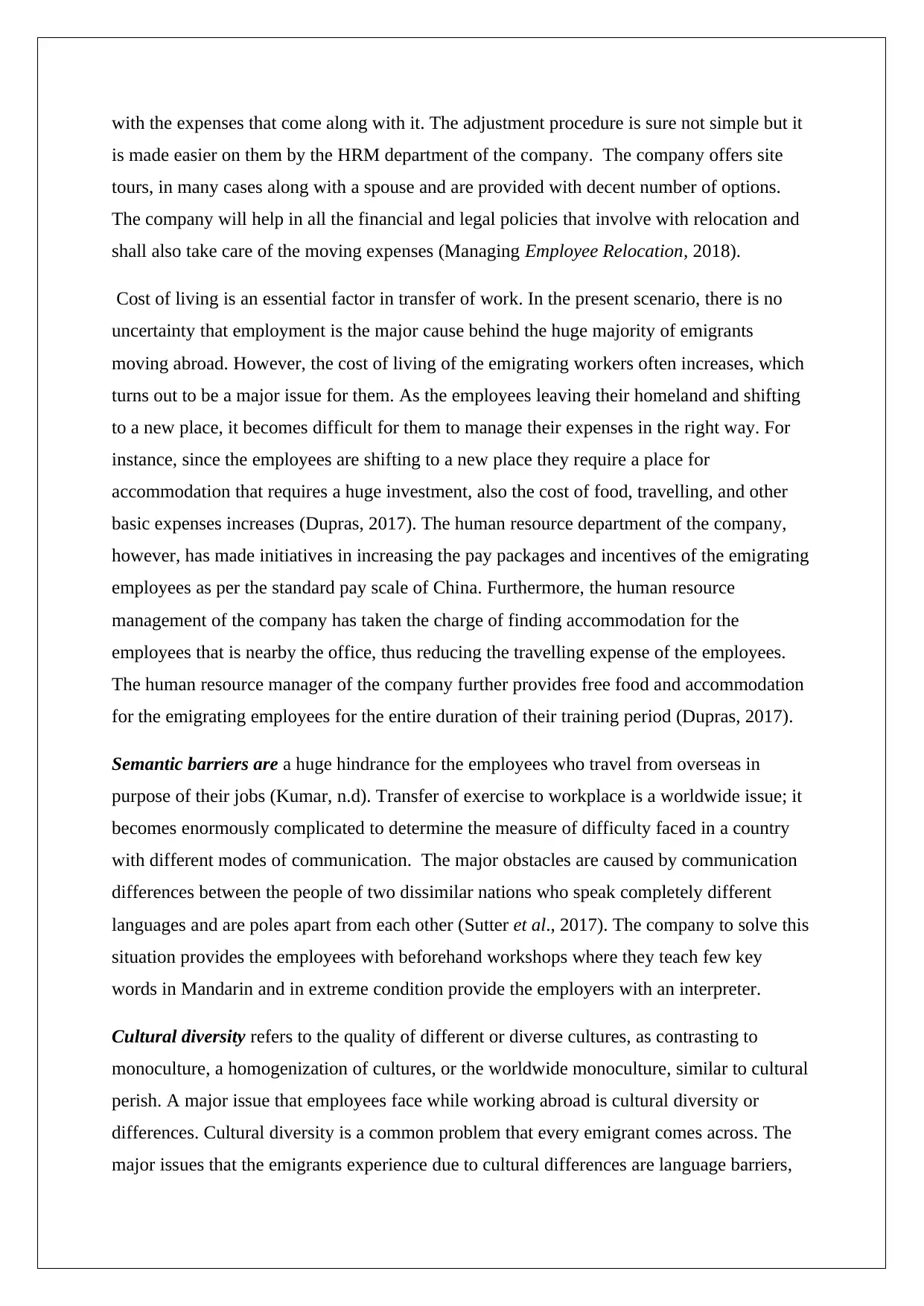
with the expenses that come along with it. The adjustment procedure is sure not simple but it
is made easier on them by the HRM department of the company. The company offers site
tours, in many cases along with a spouse and are provided with decent number of options.
The company will help in all the financial and legal policies that involve with relocation and
shall also take care of the moving expenses (Managing Employee Relocation, 2018).
Cost of living is an essential factor in transfer of work. In the present scenario, there is no
uncertainty that employment is the major cause behind the huge majority of emigrants
moving abroad. However, the cost of living of the emigrating workers often increases, which
turns out to be a major issue for them. As the employees leaving their homeland and shifting
to a new place, it becomes difficult for them to manage their expenses in the right way. For
instance, since the employees are shifting to a new place they require a place for
accommodation that requires a huge investment, also the cost of food, travelling, and other
basic expenses increases (Dupras, 2017). The human resource department of the company,
however, has made initiatives in increasing the pay packages and incentives of the emigrating
employees as per the standard pay scale of China. Furthermore, the human resource
management of the company has taken the charge of finding accommodation for the
employees that is nearby the office, thus reducing the travelling expense of the employees.
The human resource manager of the company further provides free food and accommodation
for the emigrating employees for the entire duration of their training period (Dupras, 2017).
Semantic barriers are a huge hindrance for the employees who travel from overseas in
purpose of their jobs (Kumar, n.d). Transfer of exercise to workplace is a worldwide issue; it
becomes enormously complicated to determine the measure of difficulty faced in a country
with different modes of communication. The major obstacles are caused by communication
differences between the people of two dissimilar nations who speak completely different
languages and are poles apart from each other (Sutter et al., 2017). The company to solve this
situation provides the employees with beforehand workshops where they teach few key
words in Mandarin and in extreme condition provide the employers with an interpreter.
Cultural diversity refers to the quality of different or diverse cultures, as contrasting to
monoculture, a homogenization of cultures, or the worldwide monoculture, similar to cultural
perish. A major issue that employees face while working abroad is cultural diversity or
differences. Cultural diversity is a common problem that every emigrant comes across. The
major issues that the emigrants experience due to cultural differences are language barriers,
is made easier on them by the HRM department of the company. The company offers site
tours, in many cases along with a spouse and are provided with decent number of options.
The company will help in all the financial and legal policies that involve with relocation and
shall also take care of the moving expenses (Managing Employee Relocation, 2018).
Cost of living is an essential factor in transfer of work. In the present scenario, there is no
uncertainty that employment is the major cause behind the huge majority of emigrants
moving abroad. However, the cost of living of the emigrating workers often increases, which
turns out to be a major issue for them. As the employees leaving their homeland and shifting
to a new place, it becomes difficult for them to manage their expenses in the right way. For
instance, since the employees are shifting to a new place they require a place for
accommodation that requires a huge investment, also the cost of food, travelling, and other
basic expenses increases (Dupras, 2017). The human resource department of the company,
however, has made initiatives in increasing the pay packages and incentives of the emigrating
employees as per the standard pay scale of China. Furthermore, the human resource
management of the company has taken the charge of finding accommodation for the
employees that is nearby the office, thus reducing the travelling expense of the employees.
The human resource manager of the company further provides free food and accommodation
for the emigrating employees for the entire duration of their training period (Dupras, 2017).
Semantic barriers are a huge hindrance for the employees who travel from overseas in
purpose of their jobs (Kumar, n.d). Transfer of exercise to workplace is a worldwide issue; it
becomes enormously complicated to determine the measure of difficulty faced in a country
with different modes of communication. The major obstacles are caused by communication
differences between the people of two dissimilar nations who speak completely different
languages and are poles apart from each other (Sutter et al., 2017). The company to solve this
situation provides the employees with beforehand workshops where they teach few key
words in Mandarin and in extreme condition provide the employers with an interpreter.
Cultural diversity refers to the quality of different or diverse cultures, as contrasting to
monoculture, a homogenization of cultures, or the worldwide monoculture, similar to cultural
perish. A major issue that employees face while working abroad is cultural diversity or
differences. Cultural diversity is a common problem that every emigrant comes across. The
major issues that the emigrants experience due to cultural differences are language barriers,
Paraphrase This Document
Need a fresh take? Get an instant paraphrase of this document with our AI Paraphraser
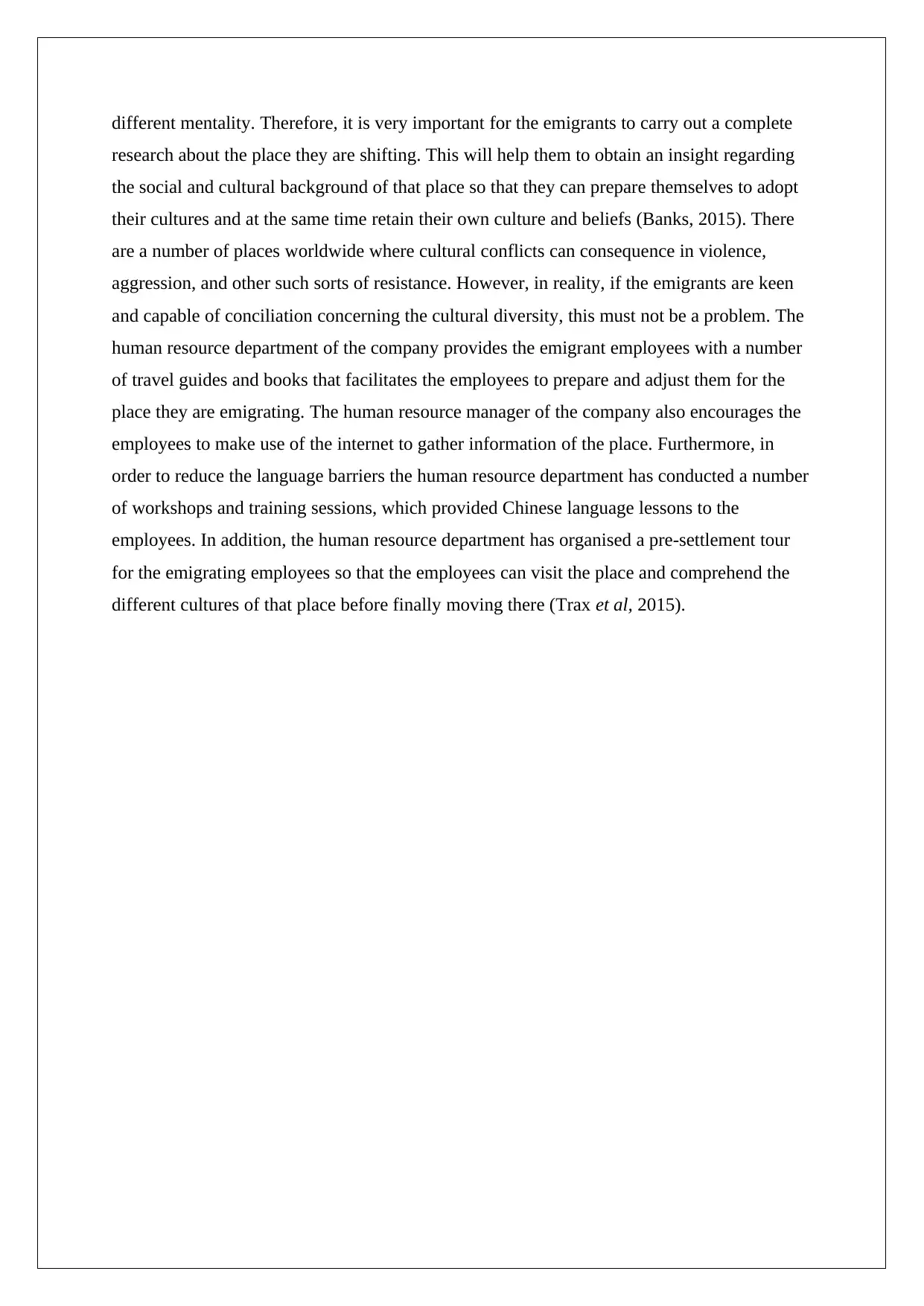
different mentality. Therefore, it is very important for the emigrants to carry out a complete
research about the place they are shifting. This will help them to obtain an insight regarding
the social and cultural background of that place so that they can prepare themselves to adopt
their cultures and at the same time retain their own culture and beliefs (Banks, 2015). There
are a number of places worldwide where cultural conflicts can consequence in violence,
aggression, and other such sorts of resistance. However, in reality, if the emigrants are keen
and capable of conciliation concerning the cultural diversity, this must not be a problem. The
human resource department of the company provides the emigrant employees with a number
of travel guides and books that facilitates the employees to prepare and adjust them for the
place they are emigrating. The human resource manager of the company also encourages the
employees to make use of the internet to gather information of the place. Furthermore, in
order to reduce the language barriers the human resource department has conducted a number
of workshops and training sessions, which provided Chinese language lessons to the
employees. In addition, the human resource department has organised a pre-settlement tour
for the emigrating employees so that the employees can visit the place and comprehend the
different cultures of that place before finally moving there (Trax et al, 2015).
research about the place they are shifting. This will help them to obtain an insight regarding
the social and cultural background of that place so that they can prepare themselves to adopt
their cultures and at the same time retain their own culture and beliefs (Banks, 2015). There
are a number of places worldwide where cultural conflicts can consequence in violence,
aggression, and other such sorts of resistance. However, in reality, if the emigrants are keen
and capable of conciliation concerning the cultural diversity, this must not be a problem. The
human resource department of the company provides the emigrant employees with a number
of travel guides and books that facilitates the employees to prepare and adjust them for the
place they are emigrating. The human resource manager of the company also encourages the
employees to make use of the internet to gather information of the place. Furthermore, in
order to reduce the language barriers the human resource department has conducted a number
of workshops and training sessions, which provided Chinese language lessons to the
employees. In addition, the human resource department has organised a pre-settlement tour
for the emigrating employees so that the employees can visit the place and comprehend the
different cultures of that place before finally moving there (Trax et al, 2015).

Conclusion
The project had been undertaken to understand the concept of human resource department.
The different training methods used by the management have been explained in detail to
understand their effectiveness and importance in developing the skills of human resource
department. The different training methods that have been examined are cross culture
training, on the job training, outdoor training and seminar training methods. Providing
training to the employees develops their skills and increases their level of expertise. It also
motivates the staff and enables them to contribute efficiently to the growth of the firm.
The various problems faced by the workforce has also been analysed in detail to understand
their negative impact. Human resource management also deals with the problems faced by
the workforce and seeks to find solutions for their problems. The human resource manager
acts as a representative of the employees and communicates the problems of the workforce to
the management. The manager works with the management to develop effective solutions to
the problems of the workforce. It is in the interest of the organization to solve the problems of
the workforce as this will ensure their stay in the firm and motivate them to work efficiently
in achieving the goals of the firm.
The project had been undertaken to understand the concept of human resource department.
The different training methods used by the management have been explained in detail to
understand their effectiveness and importance in developing the skills of human resource
department. The different training methods that have been examined are cross culture
training, on the job training, outdoor training and seminar training methods. Providing
training to the employees develops their skills and increases their level of expertise. It also
motivates the staff and enables them to contribute efficiently to the growth of the firm.
The various problems faced by the workforce has also been analysed in detail to understand
their negative impact. Human resource management also deals with the problems faced by
the workforce and seeks to find solutions for their problems. The human resource manager
acts as a representative of the employees and communicates the problems of the workforce to
the management. The manager works with the management to develop effective solutions to
the problems of the workforce. It is in the interest of the organization to solve the problems of
the workforce as this will ensure their stay in the firm and motivate them to work efficiently
in achieving the goals of the firm.
⊘ This is a preview!⊘
Do you want full access?
Subscribe today to unlock all pages.

Trusted by 1+ million students worldwide

Reference List
Banks, J.A., 2015. Cultural diversity and education. Routledge.
Carr, E., 2015. Improving the Transfer of Training After On-the-job Training (Doctoral
dissertation, University of Wisconsin--Stout).
Dupras, J., 2017. Cost of Living. Alternatives Journal, 43(1).
Kumar, R. and Kumar, D., Employees Motivational Strategies for Organizational
Effectiveness: At Workplace.
Lenartowicz, T., Johnson, J.P. and Konopaske, R., 2014. The application of learning theories
to improve cross-cultural training programs in MNCs. The International Journal of Human
Resource Management, 25(12), pp.1697-1719.
Maguire, K. and Davies, A., 2016. Competitive regional clusters: national policy approaches.
Managing Employee Relocation. [online] Available at:
https://www.shrm.org/resourcesandtools/tools-and-samples/toolkits/pages/
managingemployeerelocation.aspx [Accessed 13 Mar. 2018].
Sutter, M. and Kieser, A., 2015. How consultants and their clients collaborate in spite of
massive communication barriers. International Journal of Business Communication,
p.2329488415613340.
Trax, M., Brunow, S. and Suedekum, J., 2015. Cultural diversity and plant-level
productivity. Regional Science and Urban Economics, 53, pp.85-96.
Waddle, T. (2018). Step by Step Guide to Cross-Cultural Training for Offshore Development
Team. [online] Blog.allshorevirtualstaffing.com. Available at:
https://blog.allshorevirtualstaffing.com/step-step-guide-cross-cultural-training-offshore-
development-teams [Accessed 13 Mar. 2018].
Banks, J.A., 2015. Cultural diversity and education. Routledge.
Carr, E., 2015. Improving the Transfer of Training After On-the-job Training (Doctoral
dissertation, University of Wisconsin--Stout).
Dupras, J., 2017. Cost of Living. Alternatives Journal, 43(1).
Kumar, R. and Kumar, D., Employees Motivational Strategies for Organizational
Effectiveness: At Workplace.
Lenartowicz, T., Johnson, J.P. and Konopaske, R., 2014. The application of learning theories
to improve cross-cultural training programs in MNCs. The International Journal of Human
Resource Management, 25(12), pp.1697-1719.
Maguire, K. and Davies, A., 2016. Competitive regional clusters: national policy approaches.
Managing Employee Relocation. [online] Available at:
https://www.shrm.org/resourcesandtools/tools-and-samples/toolkits/pages/
managingemployeerelocation.aspx [Accessed 13 Mar. 2018].
Sutter, M. and Kieser, A., 2015. How consultants and their clients collaborate in spite of
massive communication barriers. International Journal of Business Communication,
p.2329488415613340.
Trax, M., Brunow, S. and Suedekum, J., 2015. Cultural diversity and plant-level
productivity. Regional Science and Urban Economics, 53, pp.85-96.
Waddle, T. (2018). Step by Step Guide to Cross-Cultural Training for Offshore Development
Team. [online] Blog.allshorevirtualstaffing.com. Available at:
https://blog.allshorevirtualstaffing.com/step-step-guide-cross-cultural-training-offshore-
development-teams [Accessed 13 Mar. 2018].
1 out of 10
Related Documents
Your All-in-One AI-Powered Toolkit for Academic Success.
+13062052269
info@desklib.com
Available 24*7 on WhatsApp / Email
![[object Object]](/_next/static/media/star-bottom.7253800d.svg)
Unlock your academic potential
Copyright © 2020–2025 A2Z Services. All Rights Reserved. Developed and managed by ZUCOL.





